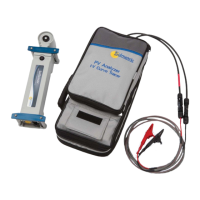6 Measuring Irradiance, Temperature, and Tilt
6-2
• The materials in which the PV cell is embedded have poor thermal conductivity,
so there can be substantial temperature drop between the cells and the module's
front side or back side.
• Temperature offset between PV cell and module backsheet depends on racking
configuration and ventilation as well as current irradiance.
• Temperature is not uniform across a PV module or array, due to variations in
racking configuration and ventilation.
• Temperature at a given location may vary with time, even at constant irradiance,
due to convection currents and wind.
• An air gap between a backside temperature sensor and the actual backside
surface results in significant temperature error.
• Massive temperature sensors, particularly bulky RTD devices, do not track rapid
changes in module temperature.
• Surface and material issues limit the accuracy of infrared temperature
measurements.
These topics are all discussed in this chapter.
The PVA software provides multiple methods for measuring irradiance, temperature, and
tilt, as shown in Table 19.
Table 19. Sensor Choices

